Piano Triads: Your Basic Chord Foundation
 If you have little or no experience playing chords on the piano, you just arrived at the right place. Virtually every chord you will ever learn will be based on one of the four types of piano triads that we will acknowledge in this lesson.
If you have little or no experience playing chords on the piano, you just arrived at the right place. Virtually every chord you will ever learn will be based on one of the four types of piano triads that we will acknowledge in this lesson.
What’s A Triad?
A triad is a chord that is comprised of only three notes. These chord structures serve as the basic foundation for other chords including 7th chords, 9th chords, and more.
These triads consist of four chord types or qualities. They are:
Major
Minor
Augmented
Diminished
A true understanding of these triads will include more than just a theoretical comprehension of them but also an appreciation for the sound quality of each type. I would highly encourage you to have fun with becoming acquainted with them. When it comes to learning to play music by ear, this will be greatly beneficial.
Let’s consider each chord quality one by one…
We will take a visual approach to learning how to easily locate and play these piano triads. Actually, once we learn one (we will begin with Major triads), the other three types will be easier to master.
Let’s take a look at the piano keyboard:

The piano keyboard is symmetrically laid out. Those black keys (called “sharps” and “flats”) form a pattern – a set of two, a set of three, a set of two, a set of three…” and on and on it repeats. That’s good news because once you have a familiarity with a little section of 12 of those keys, you’ll know the rest. So, let’s take a look at those 12:
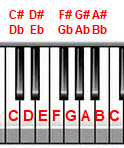
Starting on C, as we travel up to the next C (not counting that one), we have 12 different physical keys along with their names. The black keys have two names each but, of course, each of these is just one physical key. If the key names on the piano are brand new to you, perhaps you will be interested in obtaining a copy of Learning Those Ivories & Ebonies in the Amazon Kindle store. That guidebook will clear it all up for you.
Learning One Piano Triad Is Like Learning Twelve!
Okay, so we have 12 different keys. Therefore, we have 12 chords to learn for each of these qualities. This is really super news because, once you are able to play 12 chords for each chord type, you’ll have 48 chords up your sleeve!
Want even better news? You’ll be able to access them before long… within a very short amount of time. Just stick with me for a bit.
[Sidebar: If you would like to take advantage of seeing all four of these chord types demonstrated in a fun & inspiring video session, simply order Piano Chords 101 Triads below (access will be sent to your email address). You will also receive a guidebook supporting what you see in the video session. However, the video session alone is likely all you will need. It will make everything we’re talking about here really, really easy to assimilate and you’ll be encouraged to start having fun with those chords right away.]
Order Piano Chords 101 Triads – Just $11
Great. Let’s get started with the Major triads. Look at this illustration of a C Major triad on the piano keyboard. Focus on the keys highlighted in red:
 (in blue, we see the same chord in various places on the piano keyboard)
(in blue, we see the same chord in various places on the piano keyboard)
(By the way, whenever we refer to “moving up” on the keyboard, we are moving to the right – “moving down” is to the left – that makes sense because, as we move down, we play notes that sound lower and vice-versa)
The first note in this C Major triad is C. Since that is also the name of the chord, we refer to this C as the root of the chord.
It’s a common tendency for people, as they move up the keyboard, to just play the white keys. However, we’re going to use all of them.
Count Every One
Now, this is important>>>>> whenever we move from one key on the piano keyboard to the VERY NEXT KEY (up or down), we are moving by one half step. So, looking at that C (root), what is the very next key up?
Did you say D? Lots of people would. However, it’s not the really very next key, is it? There is a black key before that D, right? Yep.
We are going to count steps as we analyze this triad. So, when you count half steps, you don’t want to skip any. Keep this easy rule in mind and you’ll find this whole process to be one sweet piece of cake (flavorful, too)!
Alright. Now, imagine you are standing on that C. If you were to move up the the next note in the chord (the E in red), how many half steps would you have to pass by to get there?
(Many people will make the mistake of counting the C. But you won’t make that error because you know that C is not a step up, right? It’s simply the key we started on and are stepping from. All the others keys are considered steps.)
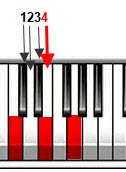
As we can see, from the C, we moved up 4 half steps to get to the next note in the chord, which is E.
Great! Now, we are going to count up in the very same way. Remember, we are currently on the E, so we are not going to count that one as we move up to the next note in the chord, which is G. How many half steps does it take to move from the E to the G?
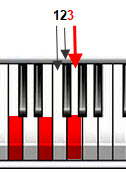
It’s pretty clear that we only had to move up 3 half steps to get to the next note in the chord, which is G.
Wahlah! We did it!
We just learned how to play a Major triad. Let’s recap what we did:
- We picked the name of the major triad we wanted to play. In this case, we chose C.
- From the C, we moved up 4 half steps to get to the next note in the chord, which was in this case E.
- From the second note in the chord (E), we moved up 3 half steps to get to the final note in the chord, which was in this case G.
Playing all three of these notes together we are playing a C Major triad!
So, remember this EASY, EASY FORMULA:
To play a Major triad: choose the name of the chord (the root), then move up 4 half steps to the next note… then move up 3 half steps to the final note.
Major triad = 4 half steps, 3 half steps.
Easy peasy!
Let’s acknowledge one point here. In the future, we are going to play some games with this triad, like switching the order of the keys where the C is sometimes the middle note and sometimes the top note of the chord. But right now we are playing the triad in root position, which means the C is at the bottom (or furthest to the left) of the chord. Remember, this is called the root position of the chord. Our formula applies when we want to form a Major triad in root position. That’s all we’re concerned with right now. By the time you get to those other positions, it won’t matter very much to you because you’ll have a better understanding of everything.
So, to play a Major triad in root position, just think “4 half steps, 3 half steps!” Yes, this is your formula for playing ANY MAJOR TRIAD IN ROOT POSITION!
Whatever hand you are going to play this triad with, by the way, you will use the thumb, middle finger, and pinkie to do so. It’s a great idea to get used to playing any chord you learn with both hands:
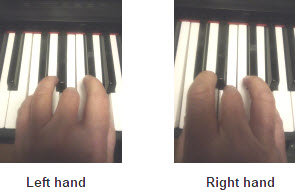
More good news! You’ll be using the same fingering for all your triads – yep, all 48 of them :o)
Are you excited? I’m excited for you because you know more than you might think you know at this point.
You have the formula for playing 12 Major triads in root position.
Did you know? So many songs out there only use just two or three of these!
Steps For Now, But It Gets Even Easier
EXTRA GOOD NEWS! We are using easy formulas to create these chords but, after a while, you won’t need them. You see, you will recognize each and every chord you ever learn visually. This will happen automatically. When you see someone you know (like a friend or relative), you instantly know who they are and what their name is, right? You don’t have to analyze what their eyebrows look like, how far apart their eyes are, or how tall they are. You simply recognize them because of their uniqueness. It will be the same way with each and every chord you ever learn… that’s a promise!
This Is How Chords Are Notated
Let’s take a look at what a tiny excerpt from a lead sheet would look like from Billy Joel’s very popular song Piano Man. See that Cmaj chord symbol? That means to play the chord we just learned. You would very likely play the triad with the root C that is one octave lower than middle C. As the illustration shows, other chord symbols could be used that mean the same exact thing:

Okay, so go ahead. Use our formula for playing an F Major triad on the piano. Which note are you going to start on? (Hee-hee, just kidding… of course you’re going to start on F.) Remember, when you count those half steps, don’t miss any. Here is what you should arrive at:
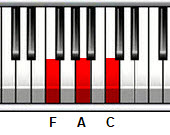
More Fun In Store For You
Wow, you’re doing fantastic! You have the formula for 12 different Major triads! Since you do, go ahead and play Major triads on these root notes:
C F Bb Eb Ab Db Gb B E A D G
I’d like to mention something here for practical reasons. Most of the time – not always – but most of the time, when you are playing a right-hand melody, these chords will be played with the left hand in this general range (with some flexibility):

You may want to invest a little time having some fun with playing major triads on all those roots mentioned above. Remember, practice them with both hands. Even though you were shown a general range that these chords are played beneath a melody, that doesn’t mean you should limit yourself to practicing them there.
Play Those Triads In Two Hands, Okay?
For example, play each triad with your left hand in a lower range while you play it with your right hand an octave higher:

You can start by getting used to playing one hand at a time, of course, but just don’t limit yourself to that. Remember, you’re becoming a chord master!
We are going to continue this lesson on playing piano triads as we explore minor triads…

